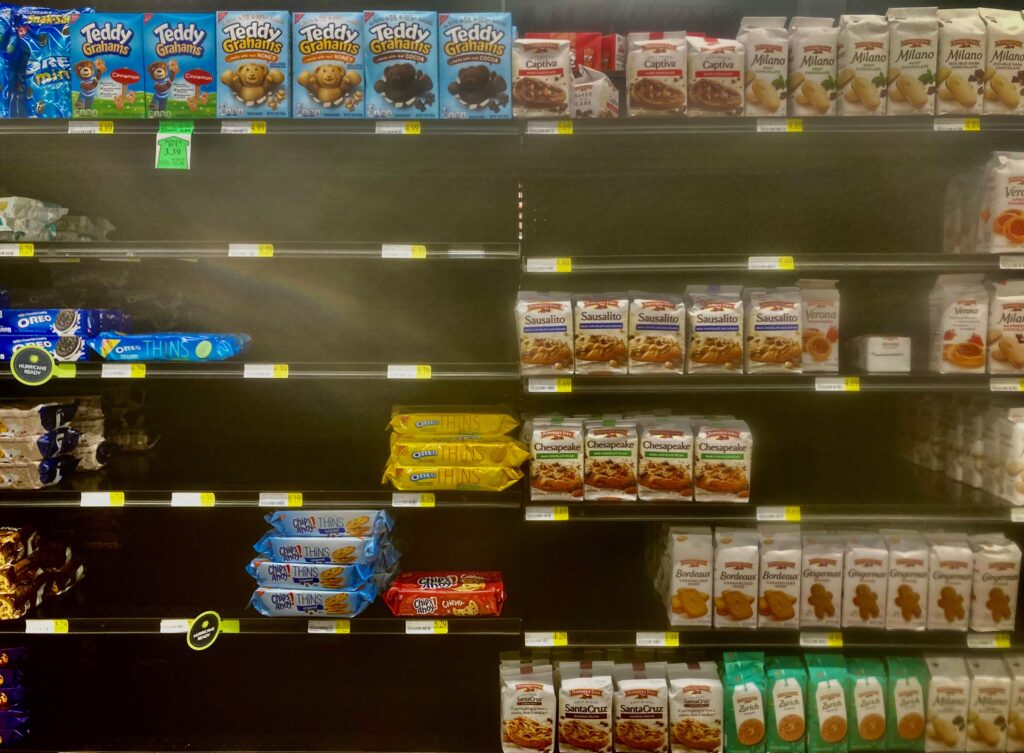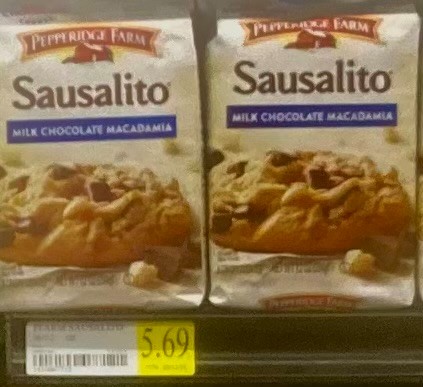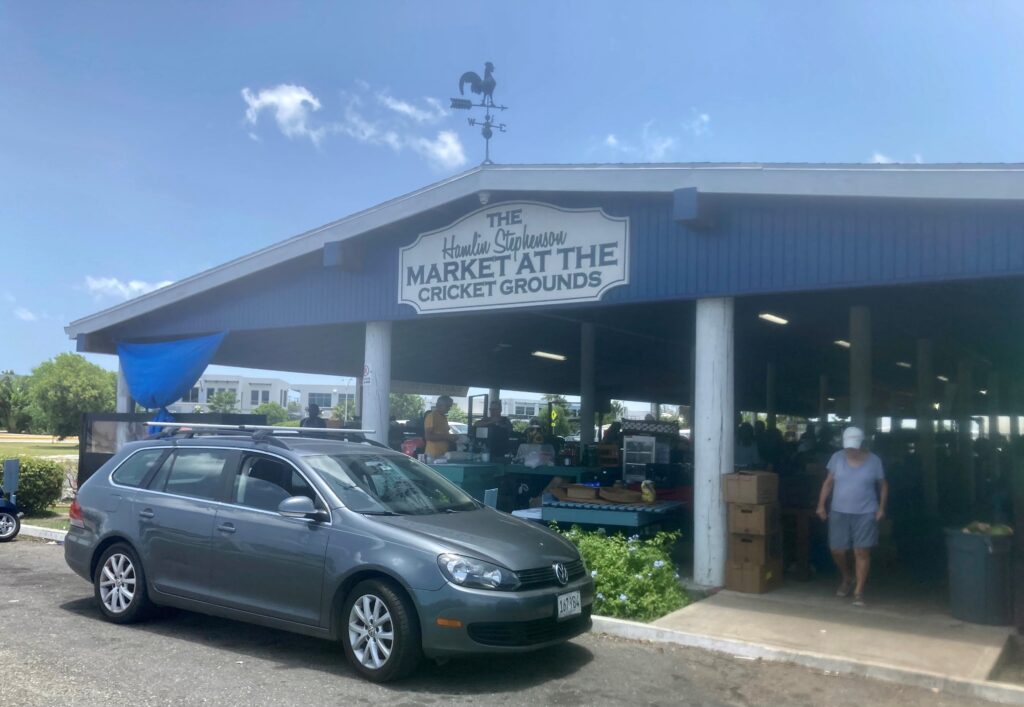by Anne Evans
Whether you are a short-stay Tourist, a Seasonal Resident or a Year-Round Local, most likely you will be doing some grocery shopping on Grand Cayman Island.
I’m going to talk about grocery shopping in stores found on Grand Cayman. Since Cayman Brac and Little Cayman are much smaller and less populated Islands of The Cayman Islands (TCI) triad, I would anticipate considerably less diversity and availability of products. (But if you’re on those islands or have visited, and you can fill us in, let me know.)
On Grand Cayman, the major grocery stores include Foster’s (a chain including 4 full-size stores), Kirk Market, and Hurley’s, all of which I would describe as most similar to US stores– except, like most businesses in TCI, they are closed on Sundays.
McRuss Grocery Stores (2 locations) are more similar to US convenience stores (and conveniently, they are open on Sundays). And then there is Cost U Less which is sort of like a mini-Costco, offering a lot of discounted household products and some food products with the emphasis on pantry staples in large volume packaging. Additionally, there is Kirk Home, that also offers discounted household products, but not food items. Plus, there is the Farmer’s Market in George Town!
Let’s Say You Are a Tourist
If this is your first time walking into any of the “Big 3” grocery stores on Grand Cayman, its going to appear pretty much like any US big chain grocery store would: an inviting ambiance of abundance, multiple checkout aisles with scanners, a big area dedicated to a vast array of prepared take-out offerings, a bakery, a produce area, meat and seafood areas on the side and back of the store, and wide middle aisles of pantry staples.
As you wander the aisles, perhaps the first thing you’ll notice are the numerous empty spots on shelves. This island relies, perhaps way too much, on imported products – and many are only available sporadically. As a tourist, you are probably surprised, and may be wondering, “Was there a recent hurricane?” As a local, you soon learn this is the way of life on The Islands.

If you are a tourist from the US, you can find many of the products you would generally purchase in the US – however, there are some unusual brands as well. If you look closer, you will see that many are imported from the UK (remember, TCI are a British Overseas Territory). Country of origin of the product impacts price – it’s an import duty thing.
Then you may begin to look at the pricing. Shelf labeling of product and amount appears at first glance kind of high – until you realize that the pricing is not in US$; it is in KY$! Then you grasp just how expensive it is to live in TCI if your income is in US$. If you pay with a US credit card, the exchange rate will be KY$1 = US$1.25. Ouch!

Or Maybe You Are a Seasonal Resident
I admit that in this brief discussion, I am making assumptions as well as perhaps character profiling the Island’s Seasonal Residents.
If you are a seasonal resident (“in season” generally from November 1 to May 1), then you most likely own (at least) one other residence and are more than comfortable with your financial situation and cash flow. Additionally, in all likelihood, you have spent enough time on Grand Cayman to understand that sporadic product availability is just a way of life here. Perhaps when you are grocery shopping, if you don’t see the food items you were intending to purchase, your response is “What me worry?” and you just eat out instead. You likely got over “Sticker Shock” a long time ago and are pretty much price insensitive when shopping.
If you spend time on Grand Cayman both in and off season, then the most apparent “in season” inconvenience for you would be (1) the crowds in the grocery store and (2) the traffic.
OR, Maybe You Live (or are thinking about living) Here Year Round as an Ex-pat … Like Me
I have been living and grocery shopping here as a year-round ex-pat for over a year now. Here are my experiences and suggestions when it comes to grocery shopping:
Product Availability
Certain products that you may come to rely on (imports from both US and non-US countries, as well as discounted generics) will not always be stocked. For me, some examples are:
- Off Deep Woods Insect Repellent (a US Import)
- Waitrose Rose Dark Chocolate Bars (a Belgium product imported from the UK)
- Waitrose Dutchy Organic Olive Oil (a product of the UK Dutchy imported from the UK)
- Equaline Vitamins and Medications (a generic line imported from the US)
- Essential Everyday Kleenex-Like Tissues (a generic line of household products imported from the US)
- Arm & Hammer Cat Litter (likely because it is the least expensive name brand)
Almost as soon as all of these products are stocked, they sell out (particularly in season) and are gone for another couple of months. My strategy – when I see them, I stock up!
Coping with Product Costs
Keep in mind that US products are priced at a premium. Certainly, some of this is because of the import duty applied. Perhaps another reason is that US tourists and Seasonal Residents are (at least to some extent) price insensitive, and so a higher markup is applied. A great example of this is purchasing eggs. US brands can be as much as KY$12 (approx. US$15 per dozen) – however if you see local eggs, they are priced on average at KY$5 (approx. US$6.25 per dozen).
This is how I deal with Grocery Store pricing & savings:
- Be willing to try products that are not of US origin (e.g., UK or British Overseas Territories) that offer better pricing. This is how we discovered the price-to-quality value and quality of Waitrose Dark Chocolate Bars imported from the UK and Anchor Butter imported from New Zealand.
- Buy local products, and in the case of the grocery stores, especially beef and pork – as well as to some extent, produce. Local beef is likely to be grass fed, lean and although relatively tougher, more flavorful than US Imported beef. Local Pork will generally carry more fat (=move flavor) than US imported Pork. Both are priced significantly less than any US imported products. Availability/cuts vary with generally once weekly restocking … so you need to look for it. “You snooze, you lose.”
- If you are wedded to (Imported) USDA Certified Prime or Choice Angus Beef, then watch for sales (roughly every 2 months at Foster’s) and stock up your freezer.
- Local Fresh Produce is available – however to a lesser extent in the major grocery stores (sadly, mostly you find US imported produce offered). However, local fresh produce can be less expensive/of higher quality if you look for it. That said, better if you are after Quality + Price = Value, then head to the Farmers’ Market (see below)
- If you are a full time Expatriate, you likely have a local bank account which may give you a better exchange rate for your imported US$ if you pay with cash rather than if you pay with a US credit card, so pay with cash.
The Art of Grocery Shopping ( i.e., as a Year-Round Ex pat)
- Firstly, understand that year-round, Saturdays from mid-morning on are busy shopping days in the 3 Major Grocery Stores (& Cost U Less is absolute bedlam). I have been told that part of the reason is that locals are generally paid Friday end of day or Saturday mornings, so that is when the locals shop.
- In Season, expect not just Saturdays but also Mondays to be challenging shopping days as Mondays appear to be the day that most Condo rentals flip and the residents head for the grocery stores in search of supplies.
- On Saturdays and Mondays, expect:
- Crowds in the Grocery Stores
- Lost tourists staring cluelessly at the shelved items mid aisle while blocking shopping cart traffic.
- Clueless tourists (predominantly Americans) pushing their carts down the right side of the aisle further obstructing shopping traffic (hey, when in Cayman, drive on the left)!
Advice
- Don’t shop on Mondays or Saturdays
- Pay attention to when Cruise Ships are in town. Their presence impacts: (1) traffic and (2) taxi availability, should the latter be your mode of transport home with groceries. This was me for the first year of our lives on this Island. We could not afford a car, and when the cruise ships were in port, it was tough to get taxi.
What about the Farmers Market
I so encourage all of you (tourist, seasonal resident, and year-round Expat) to visit & support the local farmers market: https://www.caymanfarmersmarket.com

This Island is not self-sufficient when it comes to food. As its immigrant/Expat population escalates, it becomes even less so, given the new residents’ demand for imported products. However, there is a local agricultural community here that provides locally produced fruits, vegetables, eggs, meat, and seafood. These local farmers, fisherman, and ranchers are dedicated to their professions. However, it is not an easy nor particularly profitable life for them, but instead “a labor of love”. You can find some of their products in the “Big 3” grocery stores if you look for them. However, if you want local, healthy, fresh food and the opportunity to meet those that produce it, go to the Farmers Market at Cricket Square in George Town.
Words of Wisdom
If you look like a tourist, you will most likely be charged a premium. This is a bargaining situation until the vendor recognizes you as a regular. As a regular (that perhaps looks like a tourist), ask the price, and be prepared to shake your head and walk if it is inflated.
If you are an Expat, learn the fair pricing from the locals/other expatriates. If you see something you want to buy, ask the price. If the price is too high, follow the procedure above. Frequently, the market vendors will learn to recognize you, treat you fairly, and appreciate your ongoing business. Conclusion: support local agriculture and shop at the Farmers Market. Frequently make purchases from those providers there that treat you with respect and recognize that you are a local with an intent to support their business. It is the only path to making this Island self-sufficient when it comes to healthy food provision.

